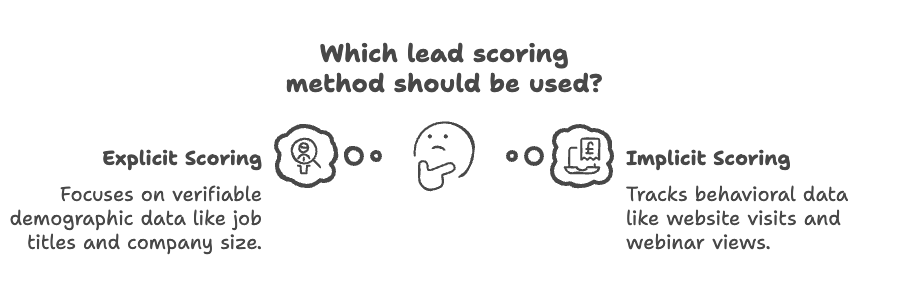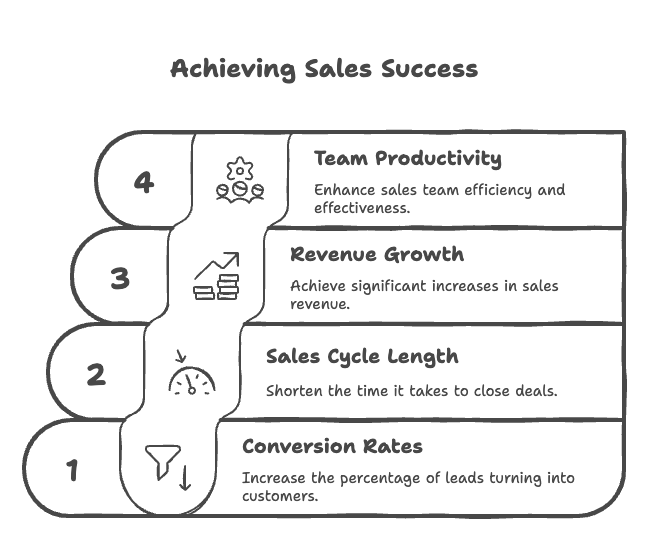Lead Scoring: Models, Tips & Best Practices
🔥 Lead Scoring: The Dating App Your Business Needs (But Way Smarter)
Let’s cut to the chase: lead scoring is like Tinder for your sales team. Instead of swiping left on every vaguely interested prospect, it helps you focus on the real matches—the ones most likely to commit (aka buy). No ghosting, no wasted time. Just cold, hard data telling you who’s worth the effort.
But here’s the kicker: 77% of companies using lead scoring see a massive ROI boost. Why? Because guessing games are for carnival booths, not sales pipelines. Let’s break down the models, tips, and tricks to turn your lead scoring from “meh” to magnificent.
🧠 Lead Scoring 101: What Even Is It?
Lead scoring ranks prospects on a scale (usually 0-100) based on how likely they are to convert. Think of it as a VIP list for your sales team. High score? Roll out the red carpet. Low score? Send ‘em a newsletter and pray.
It’s not just about saving time—it’s about alignment. Marketing stops throwing spaghetti at the wall, sales stops chasing dead ends, and everyone wins. Especially your revenue.
🤖 Lead Scoring Models: Pick Your Player
Not all leads are created equal. Here’s how to sort the gems from the gravel.
1. Explicit vs. Implicit: The “Who” vs. the “How Badly”
- Explicit scoring: This is the LinkedIn stalking approach. It judges leads by job titles, company size, or industry. (Need to verify those details? Here’s how to find a LinkedIn profile by email.)
- Implicit scoring: This tracks behavior—like how often they visit your pricing page or binge-watch your webinars. Creepy? Maybe. Effective? Absolutely.

2. Traditional Points-Based: The OG Strategy
Assign points like a game show host:
- Demographic/firmographic fit: +10 points if they’re a CEO in tech. -20 if they’re a student using a Hotmail account.
- Behavioral gold stars: +15 for attending a demo, +5 for opening an email.
- Negative scoring: -30 for unsubscribing or ghosting your emails for six months.
3. Advanced Models: For the Overachievers
- Predictive scoring: Let AI do the heavy lifting. Machine learning analyzes historical data to predict who’ll convert. No crystal ball needed.
- Matrix scoring: Combines explicit and implicit data. Think of it as a compatibility quiz for B2B relationships.
- Logistic regression: Fancy math that calculates conversion odds based on multiple factors. Perfect for data nerds.
🛠️ Building Your Lead Scoring System: A 6-Step Blueprint
- Set Non-Negotiables.
Define deal-breakers first. If you only serve the U.S., a lead from Mars gets auto-rejected. - Profile Your Dream Customer.
Industry, company size, role—build your ideal avatar. (Need employment history? Here’s how to get it for free.) - Track High-Intent Moves.
Visiting your pricing page 5x in a week? That’s the equivalent of sliding into your DMs. Prioritize it. - Assign Points Like a Pro.
Balance demographics (25%), firmographics (25%), and behavior (50%). No cap. - Set Thresholds.
- 0-50: Send cat memes (or nurture emails).
- 50-75: Warm them up with case studies.
- 75+: Ring the alarm—sales needs to pounce.
- Use Tools That Don’t Suck.
Platforms like HubSpot or ActiveCampaign automate scoring so you can focus on closing deals.
💎 Lead Scoring Best Practices: Don’t Screw This Up
- Mix demographics + behavior. A CEO who ignores your emails isn’t a lead—they’re a logo.
- Decay scores over time. That lead who downloaded your ebook in 2022? They’ve moved on.
- Separate fit from activity. Keep scores clean. Confusion = chaos.
- Score in real-time. Use tools like GetUser AI to track email engagement or find phone numbers by email for faster follow-ups.
- Negative scoring is your bouncer. Block spammy leads with disposable emails or fake forms.
🤦♂️ Common Mistakes (And How to Avoid Them)
- Scores that only go up.
Time decays everything—except your ex’s Instagram posts. Add expiration dates to points. - Over-scoring minor actions.
Three email opens ≠ buying intent. They might just love your subject lines. - Sales and marketing misalignment.
If marketing’s obsessed with webinar attendance but sales wants pricing page visits, you’ve got drama. - Ignoring AI.
Predictive scoring isn’t “optional” anymore. It’s like refusing to use GPS in 2025. - Forgetting to update.
Markets change. Your scoring model should too.
🚀 Advanced Tactics for the Bold
📈 Measuring Success: Show Me the Money
- Conversion rates: Did scoring turn more leads into customers?
- Sales cycle length: Are deals closing faster?
- Revenue growth: Cha-ching.
- Team productivity: Are sales reps finally ditching the “spray and pray” method?

📖 Case Study: From 30% to 80% Conversion
An education company used logistic regression to score leads. Result? Their conversion rate tripled. Sales stopped chasing randos and focused on hot leads. Moral of the story: Math works.
🔮 The Future: AI, Baby
Lead scoring’s getting smarter. AI will soon predict leads before they even know they’re interested. Stay ahead or get left behind.
❓ FAQ: Your Burning Questions, Answered
- How can I integrate predictive intelligence into my current lead scoring model?
Start with tools like HubSpot or 6sense. Feed historical data into AI algorithms to uncover hidden patterns. - What’s the difference between firmographic and demographic scoring?
Firmographics = company traits (size, industry). Demographics = individual traits (age, job title). Use both for B2B. - How often should I update my lead scoring model?
Quarterly. Markets shift, buyer behaviors evolve, and your ex’s new partner will still annoy you. - What mistakes should I avoid?
Letting scores inflate forever, ignoring sales feedback, and relying solely on manual scoring. - How does negative scoring filter spam leads?
Deduct points for fake emails, bounced messages, or inactivity. Your sales team will thank you.
Ready to stop wasting time on dead-end leads? Use these strategies, tools like GetUser AI, and a dash of common sense. Your pipeline (and sanity) will thank you. 💼✨
Data nerd @ GetUser.ai. Been helping sales teams work smarter with data since 2018. I dig into the nuts and bolts of email verification, lead research—the stuff that actually moves the needle.